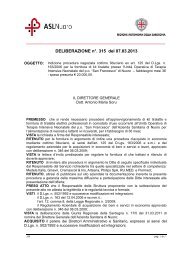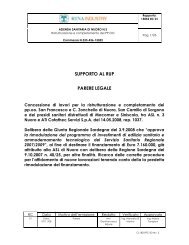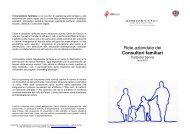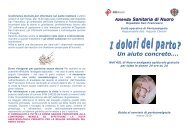Prevenzione cadute nell'anziano - Sabrina Pellicini. - Asl Nuoro
Prevenzione cadute nell'anziano - Sabrina Pellicini. - Asl Nuoro
Prevenzione cadute nell'anziano - Sabrina Pellicini. - Asl Nuoro
Create successful ePaper yourself
Turn your PDF publications into a flip-book with our unique Google optimized e-Paper software.
<strong>Prevenzione</strong> <strong>cadute</strong> nell’anziano<br />
Fattori fisiologici,<br />
patologici,<br />
ambientali,<br />
comportamentali<br />
e la paura di cadere<br />
Dott.ssa <strong>Sabrina</strong> <strong>Pellicini</strong>
Cadute nell’anziano – strumenti<br />
valutativi<br />
<strong>Nuoro</strong>, 25/05/2012<br />
Dott.ssa <strong>Sabrina</strong> <strong>Pellicini</strong>
“A fall is a potentially life-changing<br />
event for an older person. Older<br />
adults can’t bounce back from an<br />
injury like a younger person can.”<br />
Christine Branche, director of Unintentional Injury<br />
Prevention, National Center for Injury Prevention and<br />
Control of the national Center for Deases Control and<br />
Prevention, Atlanta
Perché gli<br />
anziani<br />
cadono?
Fattori di rischio fisiologici<br />
Perdita di agilità, reattività, coordinazione, capacità di<br />
adattamento posturale, acuità percettiva<br />
Sistema nervoso: Rallentamento generalizzato del movimento<br />
e dei riflessi<br />
Apparato muscoloscheletrico: Ridotta escursione articolare,<br />
perdita di volume e tono muscolare, perdita di elasticità<br />
capsulolegamentosa, degeneraz. tendinea e cartilaginea;<br />
ipercifosi dorsale con spost. ant. del baricentro, incapacità di<br />
carico a base ridotta (punte, talloni, piedi uniti, monopodalico)<br />
Sistema cardiovascolare e respiratorio: riduzione della<br />
resistenza allo sforzo e alla fatica<br />
Vista: opacità del cristallino<br />
Udito: ridotta elasticità della membrana timpanica e della<br />
catena ossiculare
Fattori di rischio patologici<br />
Perdita di forza, equilibrio, coordinazione, resistenza,<br />
riflessi, orientamento e giudizio<br />
Patologie neurologiche: Ictus, polineuropatie, demenza,<br />
m. di Parkinson, depressione<br />
Patologie muscoloscheletriche: Artrosi, esiti di interventi<br />
ortopedici di elezione (protesi), osteoporosi*<br />
Malattie cardiovascolari: alterazioni della pressione<br />
arteriosa, aritmie, cardiopatie ischemiche, arteriopatie<br />
Malattie internistiche: Diabete, broncopneumopatie,<br />
epatopatie, nefropatie<br />
Patologie della vista: cataratta, maculopatie, retinopatie,<br />
glaucoma<br />
Patologie dell’udito: ipo-anacusia
Fattori di rischio comportamentali<br />
Esposizione “volontaria” anche se inconsapevole al rischio<br />
Paura di cadere<br />
Abitudini di vita nell’utilizzo degli ambienti, di calzature e<br />
abiti “a rischio”, nei trasporti, negli orari, nell’esposizione ad<br />
eventi atmosferici e a cambiamenti climatici, nelle<br />
frequentazioni, negli hobbyes, ecc.<br />
Resistenza ai cambiamenti negli arredi, nell’utilizzo di utensili<br />
e apparecchiature (es. telefono), nella cura della casa (es.<br />
pulizia di tende e vetri) ecc.<br />
Utilizzo scorretto di ausilii mancanza di indicazioni e<br />
addestramento, tendenza al “fai da te”<br />
Isolamento tendenza a non cercare aiuto per vergogna o per<br />
“non essere di peso”, riduzione progressiva dell’attività fisica e<br />
funzionale, depressione e apatia; problemi economici<br />
Iperattività non adeguata sforzi e sport incongrui
Fattori di rischio ambientali<br />
Esposizione a rischi esterni<br />
Arredi apparecchiature elettrodomestici obsoleti o<br />
ingombranti; posizione del telefono<br />
Sedie, divani e letti molto bassi e senza possibilità di<br />
appoggio<br />
Spazi ristretti<br />
Superfici scivolose o sconnesse<br />
Ostacoli<br />
Illuminazione scarsa<br />
Oggetti di uso frequente posti ad un’altezza superiore alla<br />
persona oppure pari a quella del pavimento<br />
Animali<br />
Scale specie se senza corrimano, assenza di ascensore
La presenza di piu’ fattori di rischio<br />
contemporaneamente aumenta il rischio<br />
di <strong>cadute</strong><br />
Secondo le diverse statistiche,<br />
dal 10% al 27% nelle persone<br />
che presentano almeno 1<br />
fattore di rischio fino al 69%-<br />
78% nelle persone che ne<br />
presentano 4 o più piu’
Epidemiologia dei fattori di rischio<br />
precedenti <strong>cadute</strong><br />
polifarmacologia, farmaci<br />
particolari<br />
alterazioni della mobilità<br />
P. arteriosa
Per i farmaci in particolare, ricordiamo<br />
come un aumento del rischio di <strong>cadute</strong> sia<br />
significativamente correlato con<br />
l’assunzione di<br />
•Psicofarmaci<br />
•Antiaritmici<br />
•Diuretici
Epidemiologia dei fattori di rischio<br />
alterazioni della vista<br />
rischi domestici<br />
isolamento/disagio sociale<br />
paura di cadere
Un terzo degli anziani ha paura di<br />
cadere, anche senza storie di <strong>cadute</strong><br />
precedenti.<br />
In chi ha avuto almeno una caduta, la<br />
percentuale raddoppia, e si può sviluppare<br />
un sdr ansioso depressiva che porta ad<br />
una marcata autolimitazione funzionale<br />
(non uscire di casa, non svolgere attività<br />
fisiche e ricreative, trascurarsi, soprattutto<br />
nell'igiene)
Fattori di rischio ulteriori<br />
Camminare con un bastone<br />
Malattie cardiovascolari<br />
Avanzare dell’età<br />
Sesso femminile<br />
Utilizzo di lenti multifocali<br />
Artrite e artrosi<br />
Condizioni precarie di salute generale<br />
Demenza<br />
Depressione, Epilessia, Difficoltà nell'estensione delle<br />
ginocchia, Confusione<br />
Deterioramento cognitivo, incontinenza urinaria: non vi<br />
sono sufficienti prove per considerarli fattori di rischio<br />
(LGN 2007/2009)
Attività funzionali più a rischio<br />
nell'equilibrio<br />
Vestirsi (OR = 7,4)<br />
Camminare (OR = 4,7)<br />
Alzarsi da una sedia (OR = 3,6)<br />
(Lamb SE et al. Stroke 2003)
A più tardi……
<strong>Prevenzione</strong> <strong>cadute</strong> nell’anziano<br />
Scale di valutazione<br />
validate e<br />
standardizzate<br />
Dott.ssa <strong>Sabrina</strong> <strong>Pellicini</strong>
La valutazione del paziente<br />
a rischio di <strong>cadute</strong> e’ il<br />
cardine essenziale per la<br />
messa a punto di efficaci<br />
misure preventive (per le<br />
<strong>cadute</strong>…prevedibili!)
chi<br />
cosa<br />
come<br />
quando
CHI VALUTA<br />
Uno o più professionisti con<br />
competenze specifiche ed<br />
esperienza o formati<br />
nell'ambito delle <strong>cadute</strong><br />
(team multidisciplinare)
Cosa<br />
Popolazione a rischio<br />
Fattori di rischio
Generale<br />
Identificazione della<br />
popolazione a rischio<br />
Domiciliare<br />
Residenziale<br />
Ospedaliero
Identificazione della<br />
popolazione a rischio<br />
A basso rischio: pz. pervenuto a esame clinico<br />
generico o di routine, con storia di singolo e isolato<br />
episodio di caduta, autonomo residente nel proprio<br />
domicilio ecc.<br />
Ad alto rischio: pz. presentatosi per lesione da<br />
caduta, storia di <strong>cadute</strong> ricorrenti, presenza di<br />
specifici fattori di rischio, istituzionalizzazione ecc.
Come<br />
Approccio<br />
multidisciplinare<br />
Professionisti<br />
competenti<br />
e formati<br />
Algoritmi<br />
valutativi<br />
Scale di<br />
valutazione
Fall Evaluation Assessment<br />
Storia e circostanze della/e <strong>cadute</strong><br />
Anamnesi patologica<br />
Valutazione neurologica<br />
Valutazione dell'acuità visiva<br />
Valutazione cardiovascolare<br />
Scale di valutazione standardizzate
Strumenti di valutazione del rischio<br />
pragmatici<br />
non richiedono equipaggiamento<br />
particolare<br />
somministrati da professionisti con<br />
competenze specifiche<br />
semplice esecuzione<br />
breve durata<br />
standardizzati e validati
Valutazione rischio in ambito ospedaliero<br />
Conley (Conley J. et al.1998)<br />
Stratify (Oliver D. et al.1997)<br />
Morse Fall Scale (Morse J. et al. 1997)<br />
Hendrich Fall Risk Assessment (Hendrich et al.<br />
1995)
Scala di Conley (1998) (presenza di rischio: score> 2)<br />
Negli ultimi 3 mesi: Si’ No<br />
C1 – E’ caduto? 2 0<br />
C2 – Ha mai avuto vertigini o capogiri? 1 0<br />
C3 – Le e’ mai capitato di perdere urine o feci<br />
mentre faceva il bagno? 1 0<br />
Deterioramento motorio-cognitivo<br />
C4 – Compromissione della marcia, passo stri-<br />
sciante,ampia base d’appoggio,marcia instabile 1 0<br />
C5 – Agitato (eccessiva attivita’ motoria,solita-<br />
Mente non finalizzata,associata ad agitazione<br />
interiore, ecc.) 2 0<br />
C6 – Deterioramento delle capacita’ di giudizio/<br />
mancanza di senso del pericolo 3 0
STRATIFY risk assessment tool (1998)<br />
Item - Score: Yes = 1 No = 0 (soglia di rischio non<br />
specificata)<br />
1) Il paziente si è presentato in ospedale per una<br />
caduta o è caduto in reparto dal momento del ricovero<br />
in poi?<br />
Pensi che il paziente abbia:<br />
2) Agitazione (eccessiva attività motoria non<br />
finalizzata)?<br />
3) Problemi di vista tali da compromettere le attività<br />
della vita quotidiana?<br />
4) Bisogno di andare in bagno con particolare<br />
frequenza (>3 ore)?<br />
5) Punteggio di mobilità + trasferimenti di 3 o 4<br />
(paziente che si muove ma con assistenza o ausilii)?
Stratify - Calcolo per il punteggio al 5° quesito<br />
Trasferimenti sedia-letto<br />
0=incapace, 1=assistenza elevata (1 o 2 persone,<br />
ausilii), 2=assistenza minima (verbale o fisica),<br />
3=indipendente<br />
Locomozione<br />
0=immobile, 1=indipendente con la carrozzina,<br />
2=cammina con l’aiuto di 1 persona, 3=indipendente<br />
“0” = livello peggiore “6”= livello migliore
1. Precedenti <strong>cadute</strong>: recenti<br />
o entro i tre mesi<br />
Morse Fall Scale (1997)<br />
No = 0 Sì = 25<br />
2. Pluripatologie No = 0 Sì = 15<br />
3. Ausilii per la<br />
deambulazione<br />
Nessuno, allettato, in carrozzina, con assistente = 0<br />
Stampelle, bastone, deambulatore = 15<br />
Appoggio ai mobili = 30<br />
4. Accessi venosi No = 0 Sì = 20<br />
5. Cammino/trasferimenti<br />
Normale, allettato, immobile = 0<br />
Debole= 10<br />
Alterato= 20<br />
6. Stato mentale Consapevole delle proprie capacità = 0<br />
Dimentica i propri limiti= 15<br />
Morse Fall Score*<br />
High Risk 45 and higher<br />
Moderate Risk 25 - 44<br />
Low Risk 0 - 24
Hendrich Fall Risk Assessment (1995)<br />
(basso punteggio = basso rischio, punteggio alto=alto rischio)<br />
Risk Factor Scale Score<br />
Cadute recenti Sì 7<br />
No 0<br />
Alterazioni della minzione (incontinenza notturna, frequenza) Sì 3<br />
No 0<br />
Confusione/disorientamento Sì 3<br />
No 0<br />
Depressione Sì 4<br />
No 0<br />
Vertigini Sì 3<br />
No 0<br />
Scarsa mobilità/Debolezza generalizzata Sì 2<br />
No 0<br />
Scarsità di giudizio (se non confuso) Sì 3
Valutazione rischio in ambito non ospedaliero<br />
Timed Up and GO TUG (Podsiadlo D. et al. 1991, Mathias et al.<br />
1986)<br />
Berg Balance Scale BBS (Berg K. et al. 1989)<br />
Functional Reach FR (Duncan PM. J Geront Med sci 1990)<br />
Activities-specific Balance Confidence ABC<br />
(Powell LE et al. J Geront Med sci 1990)<br />
Dynamic Gait Index (Herdman SJ. 1995)<br />
FPS (Falls Prevention Screening from Queen Mary and Westfield College and<br />
South East Institute of Public Health Guideline 1998)<br />
Tinetti (Tinetti M.E. et al 1998)<br />
One Leg Stand OLS (Michikawa K. et al. Sci 2009, Jonsson E.2004)<br />
Multiple Task Test MTT (Bloem BR 2001, Southard V 2005)
Altri strumenti utili<br />
Barthel Index<br />
FIM<br />
Norton Plus<br />
Minimental State<br />
CERA Vision Screening Kit<br />
AUDIT Alcohol Use Disorders Identification Test<br />
Short Form – 12 SF – 12<br />
Test su Qualità di vita<br />
Test più complessi (stato di salute globale,<br />
condizioni socio-economiche e demografiche)<br />
Minimum Data Set- Home Care MSD-HC<br />
Changes in the Health, End Stage Disease and Signs<br />
and Symptoms of medical problems CHESS
THE TIMED UP & GO TEST FOR<br />
FALL RISK ASSESSMENT<br />
1. Il paziente è in posizione seduta<br />
2. Si pone un oggetto visibile a circa 2,5 m di distanza dal<br />
paziente<br />
3. Il paziente deve alzarsi, girare intorno all’oggetto e tornare a<br />
sedersi<br />
Gli si lascia la possibilità di provare una volta<br />
Tempi di esecuzione superiori a 8.5 secondi sono associati con un<br />
elevato rischio <strong>cadute</strong> negli anziani nella popolazione generale
BERG BALANCE SCALE<br />
Balance Item Score (per ogni item 0-4, “0”= livello basso,“4”= level più alto)<br />
1. Stare seduti senza supporto<br />
2. Cambio di posizione: da seduto ad eretto<br />
3. Cambio di posizione: da eretto a seduto<br />
4. Trasferimenti<br />
5. Stare in piedi senza supporto<br />
6. Stare in piedi con gli occhi chiusi<br />
7. Stare in piedi a piedi uniti<br />
8. Stare in piedi con i piedi in tandem<br />
9. Stare in piedi su una gamba sola<br />
10. Ruotare il tronco con i piedi fissi<br />
11. Recuperare oggetti dal pavimento<br />
12. Ruotare di 360°<br />
13. Fare un gradino<br />
14. Piegarsi in avanti stando in piedi TOTAL (0–56): _______<br />
Interpretation :0–20, costretto in carrozzina, 21–40, cammina con assistenza, 41–56,<br />
indipendente<br />
References Berg K, Wood-Dauphinee S, Williams JI, Maki, B: Measuring balance in the elderly:<br />
Validation of an instrument. Can. J. Pub. Health, July/August supplement 2:S7-11, 1992.<br />
Berg K, Wood-Dauphinee S, Williams JI, Gayton D: Measuring balance in the elderly: Preliminary<br />
development of an instrument. Physiotherapy Canada, 41:304-311, 1989
Functional Reach Test
The Activities-specific Balance Confidence (ABC) Scale*<br />
(Fiducia nel proprio equilibrio: anche autosomministrata o per telefono)<br />
Administration: The ABC can be self-administered or administered via personal or telephone interview.<br />
Instructions to Participants: For each of the following, please indicate your level of confidence in doing<br />
the activity without losing your balance or becoming unsteady from choosing one of the percentage points<br />
on the scale form 0% to 100%. If you do not currently do the activity in question, try and imagine how<br />
confident you would be if you had to do the activity. If you normally use a walking aid to do the activity or<br />
hold onto someone, rate your confidence as it you were using these supports.<br />
Instructions for Scoring: The ABC is an 11-point scale and ratings should consist of whole<br />
numbers (0-100) for each item. Total the ratings (possible range = 0 – 1600) and divide by 16 to<br />
get each subject’s ABC score.<br />
> 80% = high level of physical functioning<br />
50-80% = moderate level of physical functioning<br />
< 50% = low level of physical functioning Myers AM (1998)<br />
< 67% = older adults at risk for falling; predictive of future fall LaJoie Y (2004)<br />
Powell, LE & Myers AM. The Activities-specific Balance Confidence (ABC) Scale. J Gerontol Med Sci 1995;<br />
50(1): M28-34<br />
Myers AM, Fletcher PC, Myers AN, Sherk W. Discriminative and evaluative properties of the ABC Scale. J<br />
Gerontol A Biol Sci Med Sci. 1998;53:M287-M294.<br />
Lajoie Y, Gallagher SP. Predicting falls within the elderly community: comparison of postural sway, reaction<br />
time, the Berg balance scale and ABC scale for comparing fallers and non-fallers. Arch Gerontol Geriatr.<br />
2004;38:11-26.
The Activities-specific Balance Confidence (ABC) Scale<br />
For each of the following activities, please indicate your level of self-confidence by choosing a corresponding<br />
number from the following rating scale:<br />
0% 10 20 30 40 50 60 70 80 90 100%<br />
no confidence completely confident<br />
“How confident are you that you will not lose your balance or become unsteady when you…<br />
…walk around the house?<br />
…walk up or down stairs?<br />
…bend over and pick up a slipper from the front of a closet floor?<br />
…reach for a small can off a shelf at eye level?<br />
…stand on your tiptoes and reach for something above your head?<br />
…stand on a chair and reach for something?<br />
…sweep the floor?<br />
…walk outside the house to a car parked in the driveway?<br />
…get into or out of a car?<br />
…walk across a parking lot to the mall?<br />
…walk up or down a ramp?<br />
…walk in a crowded mall where people rapidly walk past you?<br />
…are bumped into by people as you walk through the mall?<br />
… step onto or off an escalator while you are holding onto a railing?<br />
… step onto or off an escalator while holding onto parcels such that you cannot hold onto the<br />
railing?<br />
…walk outside on icy sidewalks?
Dynamic Gait Index<br />
Description: Designed to test eight facets of gait.<br />
Equipment needed: Box (Shoebox), Cones (2), Stairs<br />
Scoring: A four-point ordinal scale, ranging from 0-3<br />
(Normale - Mild – Moderate – Severe Impairment).<br />
“0” indicates the lowest level of function and “3” the<br />
highest level of function. Total Score = 24<br />
Interpretation: < 19/24 = predictive of falls in the<br />
elderly 22/24 = safe ambulators<br />
References: Herdman SJ. Vestibular Rehabilitation. 2 nd ed. Philadelphia, PA:<br />
F.A.Davis Co; Shumway-Cook A, Woollacott M. Motor Control Theory and<br />
Applications, Williams and Wilkins Baltimore, 1995: 323-324
Dynamic Gait Index<br />
1. Gait level surface Walk at your normal speed from here to the next mark (20’)<br />
2. Change in gait speed Begin walking at your normal pace (for 5’), when I tell you “go,” walk<br />
as fast as you can (for 5’). When I tell you “slow,” walk as slowly as you can (for 5’).<br />
3. Gait with horizontal head turns Begin walking at your normal pace. When I tell you to<br />
“look right,” keep walking straight, but turn your head to the right. Keep looking to the right<br />
until I tell you, “look left,” then keep walking straight and turn your head to the left. Keep your<br />
head to the left until I tell you “look straight,“ then keep walking straight, but return your head<br />
to the center.<br />
4. Gait with vertical head turns Begin walking at your normal pace. When I tell you to “look<br />
up,” keep walking straight, but tip your head up. Keep looking up until I tell you, “look down,”<br />
then keep walking straight and tip your head down. Keep your head down until I tell you “look<br />
straight,“ then keep walking straight, but return your head to the center.<br />
5. Gait and pivot turn Begin walking at your normal pace. When I tell you, “turn and stop,”<br />
turn as quickly as you can to face the opposite direction and stop.<br />
6. Step over obstacle Begin walking at your normal speed. When you come to the shoebox,<br />
step over it, not around it, and keep walking.<br />
7. Step around obstacles Begin walking at normal speed. When you come to the first cone<br />
(about 6’ away), walk around the right side of it. When you come to the second cone (6’ past<br />
first cone), walk around it to the left.<br />
8. Steps Walk up these stairs as you would at home, i.e., using the railing if necessary. At the<br />
top, turn around and walk down. TOTAL SCORE: ___ / 24
Multiple Task Test<br />
Si compone di tre tipologie di items che indagano<br />
1) Componenti motorie posturali 2) Abilità cognitive<br />
3) Fattori ambientali (trasporto di oggetti vuoti o pesi,<br />
scarpe con suola scivolosa, scarsa illuminazione),<br />
variamente combinati tra loro in maniera da definire 8<br />
“compiti” di complessità crescente; il primo consiste<br />
nella performance del Timed up and go, via via reso più<br />
difficile dall’aggiunta di altri elementi. Viene misurato il<br />
tempo di performance anche se non è determinante per<br />
il punteggio; lo score è separato per items cognitivi e<br />
motori; gli errori sono annotati come “esitazione”<br />
(esecuzione lenta e incerta) e “blocco” (cessazione<br />
dell’esecuzione)<br />
E’ stato usato nei pazienti con sdr. Di Parkinson
Falls Prevention Screening<br />
Precedenti <strong>cadute</strong> (1 o più nell’ultimo anno)<br />
Numero di farmaci (più di 4 al giorno)<br />
Soppressori del sistema nervoso centrale (1 o più per piùdi 2 settimane)<br />
Alcool (più di un’unità di alcool - 1bicchiere - al giorno)<br />
Ipotensione posturale (20 mm Hg di cad uta della PBtra supino ed eretto o<br />
vertigini nell’alzarsi)<br />
Vista (difficoltà nel leggere, ritrovare un oggetto nella stanza, recente utilizzo di<br />
lenti bifocali)<br />
Udito (difficoltà nel sentire una conversazione)<br />
Cammino/passo (passi insicuri, striscianti, irregolari; costretto a stare in casa)<br />
Trasferimenti (perdita del controllo mentre si sposta tra superfici)<br />
Equilibrio (ha bisogno di appoggiarsi ai mobili, usa bastone o deambulatore)<br />
Rischi ambientali (rischi da scivolamento, inciampo, oggetti fuori posto)
Table 1 Risk factor assessment<br />
Risk factor and test used Description Measure<br />
Quadriceps strength: Spring gauge11 Leg extension while seated, with hip and knee angles at 90°<br />
with gauge attached by strap around leg 10 cm above ankle Weight (kg)—best of three attempts on<br />
each leg<br />
Balance: Postural sway Two conditions, standing in bare feet: (a) on floor in bare feet and (b) on<br />
polyetherurethrane foam pad (8.5 x 70 x 62 cm, 23 kg/m3), using Lord swaymeter to record body<br />
displacement at waist level Log of product of maximal anteriorposterior and lateral sway in each period<br />
of 30 s Maximal balance range11 Leaning forwards and backwards without bending at hips, as far as<br />
possible, using Lord swaymeter to record anteriorposterior distance moved at waist level<br />
Distance (cm)—best of three attempts Coordinated stability11 With Lord swaymeter attached at waist<br />
level and in participant‘s view, adjust balance by moving upper body (but not feet) to<br />
make tracing within convoluted track printed on paper on adjustable height table Sum of number of<br />
times pen tracing failed to stay within track, plus 5 points for each corner cut Timed “up and go” Stand<br />
from chair with no arms, walk three metres, then walk back and sit down Time (s)<br />
Vision: Visual acuity13 Dual visual acuity chart (Australian Vision Charts); uniocular measurement with<br />
distance glasses, seated in best lit room, 2 m from chart; reading low contrast letters then high contrast<br />
letters LogMAR calculated from smallest visual angle correctly perceived (line or part line of smallest<br />
letters correctly read)<br />
Stereopsis: Random dot stereo butterfly test Identification of butterfly configuration hidden in random<br />
dot pattern Able/not able to identify Crossed disparity circles Identification of decreasingly disparate<br />
circles No of last correctly identified set of circles Field of view<br />
OKP glaucoma screening test: series of numbers in spiral configuration with black stimulus spot in<br />
middle; uniocular measurement requiring reading of numbers in consecutive order, and identification<br />
of any numbers viewed where black spot disappears Sum of the number of points where black spot<br />
disappears; the result is abnormal if any number(s) make the spot disappear<br />
Home hazards: Home hazard assessment tool Walkthrough checklist for rooms used in a normal week;<br />
focus on steps and stairs, floor surfaces, lighting, bathroom fittings, furniture Number of hazards
CHECK-LIST for potential enviromental hazards (Tideiksaar R. 1986, cit. Tinetti ME 1999)<br />
Hazard Kitchen Hallways Living R. Bedroom Bathroom Any R.<br />
Dim lighting, shadows, or glare<br />
Light switches not clearly marked,<br />
cannot be seen in the dark<br />
Pathways not clear; small objects,<br />
cord, or tripping hazards present<br />
Carpet edges curling or tripping<br />
Hazard<br />
Loose throw rugs, runners, mats,<br />
slip or trip hazard<br />
Frequently used items stored<br />
where there is a need to bend over<br />
or reach up.<br />
Step stool not sturdy<br />
Table not sturdy or moves easily<br />
Chair not sturdy, moves easily, or<br />
needs repair<br />
Use of low chair that is difficult to<br />
get out of<br />
Toilet seat too low or wobbly<br />
Area slippery, if non carpeted<br />
Bathtub/shower surface slippery;<br />
nonskid mat or abrasive strips<br />
not present<br />
Grab bars not present in<br />
tub/shower<br />
Two or more hazards present
L’importante è non fare<br />
confusione:<br />
gli algoritmi valutativi
CHI “FA PARTIRE” L’ALGORITMO?<br />
Medico curante (popolazione generale)<br />
Operatore a domicilio (popolazione<br />
domiciliare)<br />
Operatore della struttura<br />
assistenziale (popolazione (popolazione residenziale)<br />
residenziale)<br />
Infermiere del reparto (popolazione<br />
ospedaliera)
Messa a punto e monitoraggio<br />
interventi mirati (più operatori e<br />
professionisti competenti di diversi<br />
servizi)<br />
Valutazione (più<br />
professionisti<br />
competenti)<br />
Identificazione<br />
soggetti a<br />
rischio (1<br />
operatore)
Assistenza medica<br />
primaria: indagine<br />
su eventuali<br />
<strong>cadute</strong><br />
Cadute<br />
ricorrenti<br />
Il pz.<br />
si presenta<br />
dopo una<br />
caduta<br />
Disturbi<br />
Deam.-eq.<br />
Valutazione<br />
rischio<br />
<strong>cadute</strong><br />
No <strong>cadute</strong><br />
Singola<br />
caduta<br />
Valut.<br />
Problemi<br />
Deambulaz.<br />
equilibrio<br />
Strumenti<br />
Valutativi<br />
specifici<br />
Nessun<br />
Intervento<br />
(PROMOZIONE<br />
ALLA SALUTE)<br />
Nessun<br />
problema<br />
(Da Tinetti ME<br />
2003 modif.)<br />
Intervento<br />
multifattoriale
(Da Laurence Z.<br />
et al. 2001)
Gli interventi preventivi<br />
Mirati alla popolazione target e ai<br />
fattori di rischio<br />
Multifattoriali<br />
Affidati a staff competenti e<br />
preparati<br />
Sottoposti a monitoraggio tramite<br />
indicatori di evidenza ed efficacia<br />
Interventi preventivi mirati:<br />
Appare molto importante<br />
l’inclusione di esercizi mirati<br />
per l’equilibrio nel<br />
programma (Sherrington C. et al. Am<br />
Ger Soc 2008, Pekka K. Et al. Lancet 2005)
Progetto Ass1 Triestina <strong>Prevenzione</strong><br />
<strong>cadute</strong> anziani a domicilio<br />
Fase sperimentale<br />
Valutazione con scala Tinetti<br />
e anamnesi <strong>cadute</strong> e farmaci<br />
negli accessi domiciliari<br />
effettuati dal personale della<br />
SSD Riabilitazione<br />
Elaborazione<br />
dati<br />
I° fase Corso di<br />
formazione per operatori<br />
II° fase Valutazione negli accessi di tutto il<br />
personale che opera a domicilio<br />
IV° fase messa a<br />
punto interventi<br />
mirati e loro<br />
monitoraggio<br />
III° fase<br />
Coinvolgimento MMG<br />
per messa a punto di<br />
algoritmo<br />
Elaborazione<br />
dati
Con gli strumenti valutativi corretti, la<br />
conoscenza degli interventi preventivi<br />
studiati e consigliati, una buona dose di<br />
disponibilita’ alla collaborazione in equipe,<br />
alla pazienza della verifica dei propri sforzi,<br />
non rimane che augurare a tutti gli operatori<br />
del settore<br />
BUON LAVORO!!<br />
..e grazie per l’attenzione!


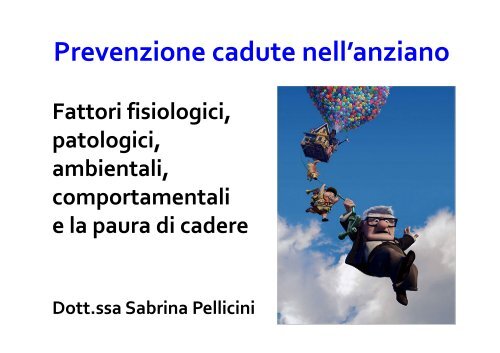
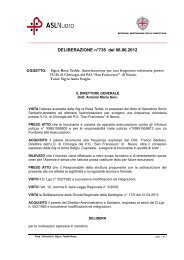
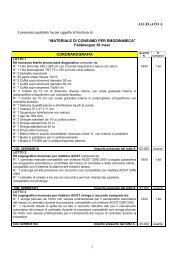
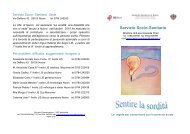
![Medicina fiscale e Commissioni Medico-legali [file.pdf] - Asl Nuoro](https://img.yumpu.com/16454349/1/190x135/medicina-fiscale-e-commissioni-medico-legali-filepdf-asl-nuoro.jpg?quality=85)
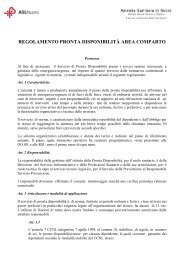
![Personale medico ed infermieristico [file.pdf] - Asl Nuoro](https://img.yumpu.com/16382904/1/184x260/personale-medico-ed-infermieristico-filepdf-asl-nuoro.jpg?quality=85)
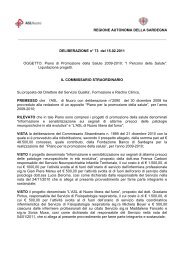
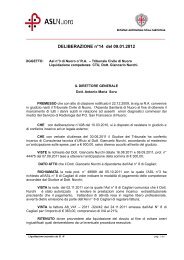
![Deliberazione n. 762 del 28 maggio 2013 [file.pdf] - Asl Nuoro](https://img.yumpu.com/16218968/1/184x260/deliberazione-n-762-del-28-maggio-2013-filepdf-asl-nuoro.jpg?quality=85)
![Carta dei servizi [file.pdf] - Asl Nuoro](https://img.yumpu.com/16034485/1/184x260/carta-dei-servizi-filepdf-asl-nuoro.jpg?quality=85)
